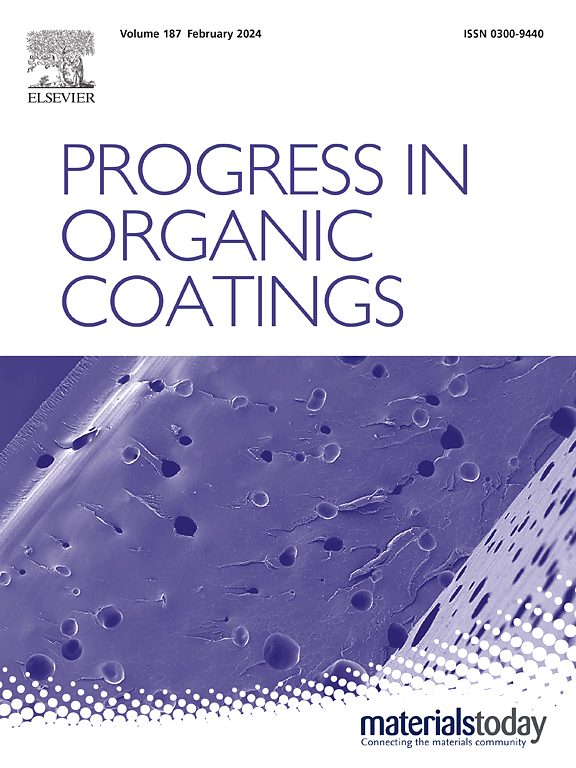Heat-resistant and high adhesion PPCD-type double crosslinked network structure waterborne polyurethane coatings
IF 6.5
2区 材料科学
Q1 CHEMISTRY, APPLIED
引用次数: 0
Abstract
Trimethylolpropane (TMP) as a cross-linker and KH-602, a siloxane coupling agent, were precisely grafted onto the branched chains of PPCD waterborne polyurethanes using molecular structure design. A series of waterborne polyurethanes (WPUs) were synthesized by selecting polycarbon dioxide-based polyol (PPCD) and isocyanate (IPDI) as soft and hard segments. The effects of changes in the content of TMP and KH-602 on the performance of the WPU coatings were investigated by analyzing the adhesion, mechanical, and thermal properties. The results showed that the thermal stability of the polyurethane coatings was significantly improved, and the decomposition temperature increased from 190.3 °C to 274 °C at a weight loss of 5 %. In addition, the water contact angle increased from 63.4° to 75.5° with the increase in polysiloxane content in the coating. This increase in hydrophobicity was accompanied by a significant increase in bond strength, with peel strength increasing 2.44-fold from 1.19 to 2.91 N/mm. This innovative formulation has excellent heat resistance and adhesion properties and therefore has potential for a wide range of applications in waterborne polyurethane coatings.
耐热高附着力 PPCD 型双交联网络结构水性聚氨酯涂料
利用分子结构设计将作为交联剂的三羟甲基丙烷(TMP)和硅氧烷偶联剂 KH-602 精确接枝到 PPCD 水性聚氨酯的支链上。通过选择聚碳酸酯基多元醇(PPCD)和异氰酸酯(IPDI)作为软段和硬段,合成了一系列水性聚氨酯(WPU)。通过分析附着力、机械性能和热性能,研究了 TMP 和 KH-602 含量的变化对 WPU 涂层性能的影响。结果表明,聚氨酯涂层的热稳定性显著提高,在重量损失 5% 的情况下,分解温度从 190.3 °C 提高到 274 °C。此外,随着涂层中聚硅氧烷含量的增加,水接触角也从 63.4°增至 75.5°。疏水性增加的同时,粘结强度也显著提高,剥离强度从 1.19 牛顿/毫米提高到 2.91 牛顿/毫米,提高了 2.44 倍。这种创新配方具有优异的耐热性和粘附性,因此在水性聚氨酯涂料中具有广泛的应用潜力。
本文章由计算机程序翻译,如有差异,请以英文原文为准。
求助全文
约1分钟内获得全文
求助全文
来源期刊

Progress in Organic Coatings
工程技术-材料科学:膜
CiteScore
11.40
自引率
15.20%
发文量
577
审稿时长
48 days
期刊介绍:
The aim of this international journal is to analyse and publicise the progress and current state of knowledge in the field of organic coatings and related materials. The Editors and the Editorial Board members will solicit both review and research papers from academic and industrial scientists who are actively engaged in research and development or, in the case of review papers, have extensive experience in the subject to be reviewed. Unsolicited manuscripts will be accepted if they meet the journal''s requirements. The journal publishes papers dealing with such subjects as:
• Chemical, physical and technological properties of organic coatings and related materials
• Problems and methods of preparation, manufacture and application of these materials
• Performance, testing and analysis.
文献相关原料
公司名称
产品信息
阿拉丁
acetone
阿拉丁
TEA
 求助内容:
求助内容: 应助结果提醒方式:
应助结果提醒方式:


